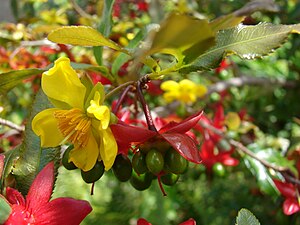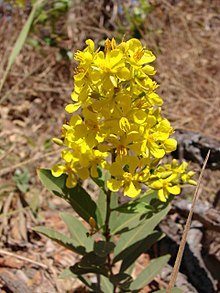Ochnaceae
| Ochnaceae | ||||||||||||
|---|---|---|---|---|---|---|---|---|---|---|---|---|

Saw-leaved nailberry ( Ochna serrulata ) |
||||||||||||
| Systematics | ||||||||||||
|
||||||||||||
| Scientific name | ||||||||||||
| Ochnaceae | ||||||||||||
| DC. |
The Ochnaceae , in German seldom also called herringbone plants or nail berry plants, are a family in the order of the Malpighia-like (Malpighiales) within the flowering plants (Magnoliopsida). The botanical name is derived from the Greek word óchne for wild pear tree. They have their areas in the subtropics to tropics in large parts of the world.
description





The species of the Ochnoideae are predominantly evergreen shrubs and trees , rarely herbaceous plants . In this family there are also some trees that collect organic material through cistern-like branches / leaves ("Trash Basket Trees"). Examples are nail berries ( ochna ) and campylospermum . The alternate, stalked leaves are usually simple, rarely composed. The leaf veins can be seen particularly clearly in most species. The leaf margins are smooth, serrated or serrated. There are stipules present.
The inflorescences can be constructed very differently. The hermaphroditic, radial symmetry flowers are often five-fold (three to ten-fold). They usually have numerous stamens , or more rarely only five or ten. The usually five to ten (rarely one to two, or even 15) carpels are free or at a (syncarp) ovary grown. The petals are often of different sizes from each other. The flowers are always nectarless.
Very different types of fruit are produced in the family; for example stone fruits , berries or capsule fruits .
use
The following is used for wood extraction :
- They are trees with a height of over 30 m and a diameter of 1.5 m. Since it is tropical wood , no annual rings can be seen. It is resistant to fungi and termites . It is used as construction timber in exterior construction, hydraulic engineering and dyke construction, as storage timber for large containers and for walls in cattle sheds; and wooden pavers, sleepers, slide rails, wooden hammers, laboratory and work tables, pergolas, stable floors and wickerwork mats are made from them. Home is West Africa.
- Izombe ( Testulea gabonensis Pellegr. ): Home is western Central Africa.
Systematics
According to APG III , the species of the former families of the Medusagynaceae Engl. & Gilg and Quiinaceae Engl. Also belong to the family of the Ochnaceae s. l.
The family of the Ochnaceae today contains 30 to 33 genera with 550 to 600 species: The family Ochnaceae is divided into four subfamilies
- Subfamily Ochnoideae Burnett : With four tribe:
- Tribus Luxembergieae Horaninow (Syn .: Luxembergioideae): With two genera and 22 species in Venezuela and Brazil:
- Luxemburgia A.St.-Hil.
- Philacra Dwyer
- Tribus Testuleeae Horaninow . It only includes the monotypical genus:
-
Testulea Pellegr. with the type:
- Testulea gabonensis Pellegr.
-
Testulea Pellegr. with the type:
- Tribus Ochneae Bartling : With nine genera and 390 tropical species, especially in Brazil:
- Brackenridgea A. Gray
- Campylospermum Tiegh.
- Elvasia DC.
- Idertia Farron
-
Lophira Banks ex CFGaertn.
- Lophira alata Banks ex CFGaertn.
- Nailberries ( Ochna L. )
- Ouratea Aubl.
- Perissocarpa Steyerm. & Maguire
- Rhabdophyllum Tiegh.
- Tribus Sauvagesieae DC. (Syn .: Euthemidaceae Solereder , Sauvagesiaceae Dum. , Wallaceaceae van Tieghem ): With about 17 genera and 82 species, especially in the Neotropic :
- Adenanthe Maguire et al.
- Adenarake Maguire & Wurdack
- Blastemanthus Planch.
- Cespedesia Goudot
- Euthemis Jack
- Fleurydora A. Chev.
- Godoya Ruiz & Pav.
- Indosinia J. E. Vidal
- Krukoviella A.C.Sm.
- Poecilandra Tul.
- Rhytidanthera Tiegh.
- Sauvagesia L. (including Indovethia Boerl. , Lauradia Vand. , Leitgebia Eichler , Neckia Korth. , Pentaspatella Gleason , Roraimanthus Gleason , Sinia Diels , Vausagesia Baill. )
- Schuurmansia flower
- Schuurmansiella Hallier f.
- Tyleria Gleason
- Wallacea Spruce ex Benth. & Hook. f.
- Tribus Luxembergieae Horaninow (Syn .: Luxembergioideae): With two genera and 22 species in Venezuela and Brazil:
- Subfamily Quiinoideae Luersson (Syn. Quiinaceae Engl. ): With four genera and about 55 species in the Neotropic :
- Subfamily Medusagynoideae Reveal (Syn .: Medusagynaceae Engl. & Gilg ). It only includes the monotypical genus:
-
Medusagyne Baker with the species:
- Jellyfish tree ( Medusagyne oppositifolia Baker ): It occurs only in the Seychelles on the island of Mahé .
-
Medusagyne Baker with the species:
swell
- The family of Ochnaceae in APWebsite. (Section systematics and description)
- Family description at DELTA. (only for the family in the original scope)
Individual evidence
- ↑ APG: An update of the Angiosperm Phylogeny Group classification for the orders and families of flowering plants: APG III , In: Botanical Journal of the Linnean Society , 2009, pp. 105-121.
- ↑ Ochnaceae in the Germplasm Resources Information Network (GRIN), USDA , ARS , National Genetic Resources Program. National Germplasm Resources Laboratory, Beltsville, Maryland.
- ↑ Julio V. Schneider, Pulcherie Bissiengou, Maria do Carmo E. Amaral, Ali Tahir, Michael F. Fay, Marco Thines, Marc SM Sosef, Georg Zizka, Lars W. Chatrou (2014): Phylogenetics, ancestral state reconstruction, and a new infrafamilial classification of the pantropical Ochnaceae (Medusagynaceae, Ochnaceae s. str., Quiinaceae) based on five DNA regions. Molecular Phylogenetics and Evolution 78: 199-214. doi : 10.1016 / j.ympev.2014.05.018
- ^ David John Mabberley: Mabberley's Plant-Book. A portable dictionary of plants, their classification and uses . 3rd ed. Cambridge University Press 2008. ISBN 978-0-521-82071-4 , page 531